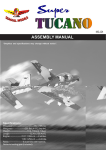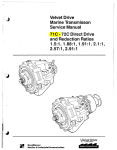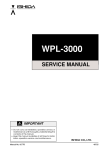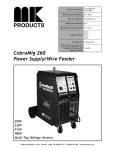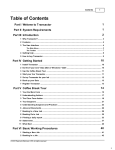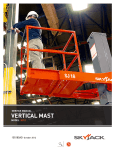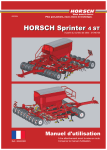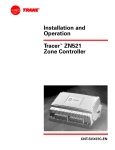Download Vectra Fitness On-Line 1650 Owner`s manual
Transcript
FITNESS On-Line 1650 ® Owner’s Manual Introduction W e at Vectra appreciate your selecting our On-Line® 1650 for your fitness program, and invite your questions and comments. We're sure that you’ll be pleased with your new Vectra gym. This owner’s manual provides you with safety rules, assembly instructions and routine inspection and maintenance information to enable you to get the most from your gym. Please read through this manual carefully before you assemble and use your On-Line® 1650. Routine Inspection & Maintenance The Vectra On-Line 1650 is designed to provide years of trouble-free service with ® minimal routine maintenance. You can be confident of continued top quality performance by carrying out the following periodic inspection. PERFORM THE FOLLOWING SAFETY CHECK DAILY: 1. Inspect cables, cable ends and nylon jacket very carefully. Refer to Warning Label for specific information on inspecting cables. This same information is repeated in this manual and on your exercise chart. Replace any damaged or worn cables. Annual cable replacement (semiannual in multi-user settings) is strongly recommended as an additional precaution. The rate at which cables wear depends on many factors including: repetitions, weight setting, misuse, abuse, etc. Because of this, periodic cable replacement is not a sufficient safeguard against unexpected breakage. Nothing short of a thorough, careful daily inspection constitutes an adequate safety program. PERFORM THE FOLLOWING CHECKS WEEKLY: 1. Inspect frame and pulley bolts for tightness. Tighten if necessary.* 2. Inspect cable attachments (short and long single handles, double handles, lat or curl bars, ankle strap, foot strap, triceps strap, sport handles such as racquet sports, golf, or baseball, ab strap, squat attachments, etc.) carefully. Look for damaged mounting eyes, springs, latches, etc. Inspect the webbing for fraying and check that the stitching is intact and strong. Inspect all joints, fixed and pivoting. Make sure any bolts are tight and that all retaining rings are intact and in good condition. Inspect any bearings. Replace any damaged or worn items. 3. Inspect weight selector pin for proper fit and retention in selector shaft. Replace improperly functioning pin (or other stack components) with Vectra replacement parts only. 4. Inspect press arm adjustment lever for proper function. Ensure that latch pin is engaging each position fully. Replace improperly functioning parts with Vectra replacement parts only. 5. Inspect press arm mounting screws for tightness. Tighten if necessary.* Inspect all springs, including press arm counter balance springs to make sure they are in good condition and working properly. Replace any missing, damaged or worn springs with Vectra replacement parts only. 6. Inspect bench bolts. Tighten if necessary.* Inspect bench wheels, wheel suspension pivots, retaining rings, spring, and braking features for proper function. Replace any damaged or malfunctioning parts. 7. Inspect leg developer mounting screws, pivots, bearings, and spring for tightness and/or proper function. Replace any damaged or malfunctioning parts. 8. Inspect cushion bolts for tightness. Tighten if necessary.* Inspect cushion support structure, squat attachments, pivots, guide wheels and associated latches. Remedy any problems found using Vectra replacement parts only. 9. Inspect all molded parts such as pulleys, nylon bushings and cable stops. Make sure all are intact, undamaged and secure. Replace any parts that are missing, worn or damaged. 10. Inspect cable retaining plugs and spring plungers. Replace if needed using Vectra replacement parts only. 11. Inspect Cross Chest Fly or Butterfly arm pivots, retainers, attachment points and adjustment mechanisms for proper function. Inspect pulley pivots, retainers, axles, bushings, attachment points and rotation limiters for proper function. Inspect non-slip tread and rubber feet on bench. Remedy any problems found using Vectra replacement parts only. 12. Adjust cable system tension if necessary (see assembly instructions for details). 13. Inspect stack column for proper rocking function. Inspect latch pins at base of stack column. Inspect press arm for adjustment (center and fore-aft). Inspect stack column latch mechanism. Repair, replace or adjust as necessary. 14. Inspect wheels on press arm. Repair or replace as necessary. 15. Inspect Leg/Calf Press option (if installed) for proper function and latching. Replace any damaged or malfunctioning parts. PERFORM THE FOLLOWING CHECKS MONTHLY: 1. Inspect all foam hand grips, pads, etc. Replace any damaged, worn, or loose parts. 2. Inspect weight plates for cracks, damaged bushings, etc. Replace if necessary. Check bolt, tighten if necessary. 4. Clean upholstery with mild soap and water as desired. 5. If unit is in a humid area, such as near a pool, hot tub or sauna, or in certain climates, use of an auto wax should delay rusting. * If any bolts seem to loosen periodically, use Loctile 242 for a long-term cure. Safety Rules WARNING: Serious injury can occur if you are struck by falling weights or moving parts. The risk that you assume by using this type of equipment can be reduced by obeying a few simple rules: 1. IMPORTANT: Cables are a wear item. It is your responsibility to prevent unexpected breakage. To do this, inspect every cable daily. Pay particular attention to areas near fittings at each end of each cable. Access panels are provided, where necessary, for this purpose. Replace worn, frayed, or damaged cables immediately. The actual wire strands, the fittings, and the nylon jacket itself must all be scrutinized. Using or allowing a machine to be used with a suspect cable can result in serious injury. 2. Inspect the nylon jacket of each cable carefully, again paying particular attention to the cable ends. This nylon jacket is essential for cable life and safety. Any cable should be replaced if the nylon jacket is missing, is damaged in any way, has pulled or shrunk away from the fittings at the end of the cable, or is discolored. DISCOLORATION, DARKENING OR BULGING OF THE JACKET IS AN EARLY INDICATION OF INTERNAL PROBLEMS SUCH AS WEAR OR FRAYING. 3. Read and follow all instructions in your owner’s manual, on your exercise chart, and on product warning/caution labels. Additional copies are available from Vectra Fitness, Inc. or your dealer. Do not use this machine until you have taken the time to become completely familiar with its safe operation. 4. Consult your physician before beginning your exercise program. 5. Do not allow young children to use or play with or around this machine. Allow older children to use the machine only with adult supervision. 6. Keep body, hair, and clothing clear of weights and moving parts at all times. Keep fingers clear of moving parts while making adjustments. 7. Inspect the gym for loose or worn parts, damaged, frayed, or worn cables, broken weight plates, etc. Do not use or allow the machine to be used until any defective parts are repaired or replaced. Refer to the “Routine Inspection and Maintenance” section of your manual for specific inspection rules. Use only Vectra authorized replacement parts. 8. Ensure that the weight selector pin is in good working condition and fully engaged in the selector shaft prior to lifting. Use only the Vectra supplied pin or a Vectra authorized replacement. 9. Ensure that any locking mechanisms are properly engaged prior to lifting. Locking mechanisms secure the following in position during use: seat pads, accessory items such as squat attachments and lat hold downs, cable attachments, press arms, leg developers, etc. An improperly engaged locking mechanism could result in an injury. 10. Obtain assistance to free jammed weight plates, pulleys, etc. Do not attempt to free jammed weight plates by yourself. Falling weight plates can cause serious injury. Do not pin the weight stack or top plate in an elevated position and do not use machine if found in this condition. 11. Do not drop the weight plates. Lift only as much as you can control safely. Never use dumbbells or other means to incrementally increase the weight resistance. Use only those means provided by Vectra. Don’t be careless, stay alert. 12. Serious injury could result if equipment moves while in use. To prevent this, ensure that the floor is even, strong, and not too slippery. If equipment slides too easily on floor, place equipment on rubber matting. Errors in lifting form could also result in bench moving in use. To prevent this, lift weight vertically only and do not push horizontally with your feet while lifting. 13. Ensure machine is fully assembled in a Vectra Fitness authorized configuration per owner’s manual prior to use. Replace any warning or caution labels on product if damaged, illegible or removed. CAUTION: SELECT “FIXED MODE” BEFORE USING THIS WEIGHT MACHINE by pushing in the handle on the tallest column. This press station offers an advanced free weight simulation that requires the user to perform actual balancing work. “FREE MODE” should only be selected after reviewing all information on exercise chart, labels and owner’s manual. (Certain exercises are to be performed in fixed mode only.) CAUTION: ATTACH LEG PRESS CABLE TO CABLE ANCHOR when not connected to the low pulley cable. Leg press footplate can move forward freely with no resistance if cable is not anchored. Before using leg press, review exercise chart, all lablels, and owner’s manual. Vectra On-Line® 1650 Cable Diagram Note: The pulleys on this diagram are numbered to make the installation of new cables as easy as possible. Simply start threading the cables through the pulleys beginning with the lowest number and working up. For example, If you are installing an entire set of cables, start at pulley #1. If you are installing only a new ab/leg cable (PN 52750), you would begin at pulley #20. Note: Where applicable, text and other drawings in this manual that mention or show pulleys contain corresponding numbers. Step 3, Cable Adjustment. See #21 (last page). 2 1 4 HIGH PULLEY 19 PN 52760 3 PN 52740 8 AB 20 Step 2, Cable Adjustment. See #21 (last page). 22 15” EXTENSION CABLE 9 PN 57820 PN 28840 PN 52750 11 PN 57790 21 10 17 7 6 18 5 16 12 14 23 LEG 15 13 LOW PULLEY Step 1, Cable Adjustment. Ball must touch slot below it. See #21 (last page). Note: Leg/Calf Press option cable is PN 61000. 3/8-16 x 1/2 Hex Bolt PN 55870 1/4-20 x 3/4 Hex Bolt PN 20850 1/2 Shaft Retainer PN 17750 Plastic Hole Plug PN 27990 1/2-13 x 1 Button Head PN 13790 Assembly Instructions Tools Required: 1. Select location for your machine. Set machine up in a well lighted and well ventilated Wrenches: One each (7/16”, 1/2”), two each (9/16”) Hex Keys: 5/16” Phillips head screwdriver, hammer, pliers 2. Unbox entire unit, taking care to not bang parts together lifting them from their foam area where you will enjoy exercising. Use rubber floor matting or carpet remnants to protect your floor if desired. supports. (NOTE: LEAVE ALL CABLE RETAINERS IN PLACE.) Lay large items, such as the main column down until needed to prevent them from accidentally falling over. To make assembly as easy as possible, many cables are pre-routed at the factory. Route and attach cables when the instructions call for it. After routing any cable, resecure it to prevent it from coming unrouted before going on. Some bolts should be tightened very tight only after the instructions say to do so. All bolts should be tight at the end of assembly. 20 B D 18 21 22 17 16 13 C 14 23 15 FIG. 1 E 3. Assemble the press arm support (A) to the main frame (B). (3/8-16 x 1/2 hex screws, qty. 4). FIG. 1. 4. In preparation for threading the cable, position the main column (C) on the right of the main frame (B), and the leg/ab station (D) on the left. Lay these parts down as shown in FIG. 1 to prevent them from falling over. You may tilt the main frame (B) on its left side to simplify cable routing. Now route the long cable from the base of the main column (C) into the opening on the right of the main frame (B) around the nearest pulley #13 and up out of the frame. The cable goes around the press arm pulley #14 such that the bolt head of the press arm pulley (E) is toward the bench, and then back down into the main frame (B) going around the other of the two pulleys #15. The cable goes through the frame and exits out the opening near the leg/ab station (D). The cable enters the base of the leg/ab station (D) through an opening in the bracket and goes under pulley #16 found there. There is a "cable-keeper" at this pulley. It is a small piece of steel about the diameter of a pencil. It is VERY IMPORTANT that the cable go between the pulley and this "cable-keeper." Now the cable goes around the lower pulley#17 of the suspended pair of pulleys, front to back. Refer to FIG. 1 and Cable Diagram elsewhere in this manual. Going around this pulley in the correct direction without the cable twisted is VERY IMPORTANT. This cable next passes under pulley #18 and exits the column as shown. 5. In preparation for attaching the stack column (F) to the main frame (B), make sure that the rear of the main frame is 2 to 3 feet from the wall. The stack column should have the guide rods (G) in place with the rubber bumpers (H) at the bottom and the screws up. IMPORTANT: The guide rods need to be in now because ceiling height might make later insertion difficult or impossible. FIG. 2. 6. Stand the stack column (F) up forward of its final position. The rockers at its base go under the spring loaded positioning pins that protrude horizontally above the felt. Place the rear of the rockers under these pins and work the column back carefully so as not to scratch the frame. Leave the factory installed frame protectors in place throughout this step. FIG. 2. The positioning pins have to rise and snap into the notches provided at the base of the stack column (F). Because the springs holding down the pins are stiff, a fair amount of force is F GUIDE required. For the last two inches, tilting the stack column (F) toward the press RODS INSIDE arm support (A) helps by making the ramps less steep. Pop one side in at a time. FIG. 3. (If disassembly is someday G necessary, it is accomplished by prying up on these horizontal pins with a very long screw driver H F while pulling the bottom of the stack B column (F) forward.) Retain the frame protectors for future FRAME disassembly/ PROTECTORS reassembly. IN PLACE FIG. 2 FIG. 3 Spring loaded positioning pin shown in latched position Assembly Instructions (cont.) 7. Now bolt the press arm lever (I) to the stack column (F) through the bearings. (1/2-13 x 1 button head screws, qty 2). Tighten very tight with 5/16" hex key. Allow the wheels on the bottom of the press arm lever to rest in the "V" of the press arm support. Attach pulley (E) to the press arm lever (I). The 5/16" diameter pin passes through the front of the press arm lever (I). On each end goes one of the steel strips of the press arm pulley (E) with installed bushing and an e-ring to retain it. Install e-rings with pliers. Make sure the cable is not twisted. FIG. 4. 8. Stand the main column (C) up and place it into position while pulling cable out under the press arm support (A). Ensure that the cable feeds straight and is not pinched. Bolt column to frame (3/8-16 x 1/2 hex screws, qty. 5). FIG. 5. 9. Feed the cable from pulley #18 in the bottom of the leg/ab station (D), into the opening in the side of the stack column (F) and have it come out the top of the stack column (F). Stand the leg/ab station (D) up and, making sure to not pinch the cable, bolt it to frame (3/8-16 x 1/2 hex screws, qty. 5). FIG. 5. F Y I A FIG. 4 FIG. 6 E 19 14 Neoprene washer E-RINGS (Shown actual size) Nylon spacer Guide rod CABLE F Weight pin ring D Rubber finish washer 5 bolts each column U-clip C FIG. 5 B 10. Now install the weight stack inside the stack column (F). First remove pulley 19 and the bolts in the tops of the guide rods. Ensure that the guide rods and stack bumpers are in position as mentioned in step 5 above. One at a time place weight plates onto guide rods at top of column with selector pin groove on bottom facing out. IMPORTANT: To safely keep plates from banging together the following procedure is suggested: after releasing each plate, pull the guide rods apart to slow the plates fall. Don't try to catch plates with hands or feet. USE EXTREME CAUTION. FIG. 6. 11. After all 20 plates are in column, feed the cable end through the weight pin ring, the rubber finish washer, and into the U-clip. Secure the U-clip to the top plate and the selector shaft with a 3/8-16x3 hex bolt. Now lower this assembly down the guide rods. Reassemble the guide rods such that the bolts pass first through the bracket, then the neoprene washers, then the nylon bushings and then into the threaded insert in the top of each guide rod. Reinstall pulley #19 such that the cable goes around it as shown. Ensure that the cable passes between the pulley and the “cable-keeper” above it. Look down the column to make sure that the cable is not wrapped around itself or a guide rod. Tighten all bolts installed in this step. Lift the top plate to the top of the column. If it is sticky near the top, adjust the guide rod spacing. FIG. 6. Label the weight stack per the instructions with the labels. The “Press Arm Adds 25 lbs.” label goes on the press arm. 18 Assembly Instructions (cont.) 12. Bolt the leg seat handle/strut/leg developer pivot assembly (K) to the leg/ab seat bottom (M) (1/4-20 x 3/4 hex screws, qty 4). Attach this assembly to the leg/ab station (D) such that the hooks on the end of the strut go into the rectangular hole on the top of the column (D). Line up the 1/2" holes and insert the pivot (1/2" diameter rod and shaft retainers). Install shaft retainer with a hammer. Bolt the ab seat back/preacher curl cushion (N) to the leg/ab station (D) (1/4-20 x 3/4 hex screws, qty. 4). FIG. 7. 13. Attach the leg developer (O) to the leg developer pivot assembly (K) (1/2-13x1 button head screw, qty. 2). Tighten very tight with 5/16" hex key. FIG. 7. Attach the cable end to the leg developer (O), securing it with plastic hole-plug. FIG. 7A. O FIG. 7 N M K FIG. 7A O D 23 FIG. 8 14. Attach the bench seat back (P) and bench seat bottom (Q) to the bench (1/4-20 x 3/4 hex screw, qty. 10). The bench handle installs between cushion (Q) and the bench frame and is held in place by 2 of these screws. Tighten firmly. FIG. 8. P Q handle FRONT VIEW FIG. 9 1" Washer Cotter pin 1" Washer Cotter pin RIGHT LEFT 15. Install right cross chest fly arm (arm closest to press station) on pivot bar. The right arm is the one with the cam at the lowest point on the arm. Install 1" washer and then cotter pin, bend end. Repeat this process for the left arm. FIG. 9. Assembly Instructions (cont.) 16. Connect cables to cross chest fly cams. Use plastic hole-plugs in keyholes to prevent disconnection. FIG. 10A. 17. Install seat bottom (R) (1/4-20 x 3/4 hex screws, qty. 2). Note: If you are installing a leg/calf press option, there are seat handles which install under seat bottom (R). See instructions with the leg/calf press option for details. Install the lat hold down (S) with the lever on the right pointing up. Line up the 1/2" holes and insert the pivot (1/2" diameter rod and shaft retainers). Install shaft retainer with a hammer. Install seat back (T) (1/4-20 x 3/4 hex screws, qty. 4). Install one single handle per side (U). FIG. 10. FIG. 10A FIG. 10 T U S LEFT CAM DETAIL R 18. Now install press handle (V). Insert the press handle (V) into the front of the press arm lever (I) such that the pin engages one of the notches inside with a bracket from the press handle on each side. A nylon bushing should be positioned (slot toward weight stack) to engage each side of the press arm lever (I). Secure each bushing with a bushing cap (W), bent flanges up. Install the screws in the sides (1/4-20 x 1/2 pan head phillips, qty. 4) and the tensioning screws (1/4-20 x 1-1/4 oval head, qty. 2). Tighten the 4 side screws finger tight. Now tighten the tensioning screws until the slop is taken up. Do not overtighten. Once the slop is removed from the pivot, but the joint still rotates easily, tighten the 4 cross screws. Check the adjustment lever's operation at this point. When the lever is operated in either direction, the pin should retract fully, allow the press handle to rotate. When the lever is released, the pin should lock the press handle by snapping all the way into the next notch. Adjust if necessary. When correctly adjusted, the latch pin will be forced by the spring all the way against the far end of the slot it travels in. The adjustment lever will pull it almost, but not all the way, to the other end of the slot. It is very important that it be adjusted such that it goes all the way to the end of the slot with the pressure of the spring. Now install the plastic cover (X). With the textured side out, insert the narrow end down into the front of the press arm lever (I). Curve it back and insert the end with the hole under the top of the press arm lever (I). The hole snaps onto a hook inside to secure it. FIG. 11. 19. Next adjust the position of the stack column. First make sure all frame bolts are very tight. Behind the stack, near the floor on each leg of the main frame (B) you will find a bolt head. Turning either bolt head (9/16" wrench) will move the bottom of that side of the stack column (F). Clockwise moves the bottom of the stack back, counter-clockwise forward. Make sure the "Mode Selection Knob" near the top of the main column (C) is in "Free Mode." The wheels on the bottom of the press arm lever (I) will be in the "V" of the saddle of the press arm support (A). First adjust the bottom of the stack column to center the wheels on the press arm support (A). Once this is accomplished, check the alignment of the "Mode Selection Knob." If it slides into "Fixed Mode" easily, go to the next step. If it hits one side of the hole first, more adjustment is necessary. To bring the top of the stack column (F) toward the press station, the bottom of the stack needs to go away. Turn the two bolt heads clockwise. Turn them an equal number of turns to keep the press arm centered on the press arm support (A). To move the top of the stack column back, turn the bolt heads counterclockwise. FIG. 12. FIG. 11 TENSIONING SCREWS I X W V FIG. 12 F B Stack Column Position Adjustment Assembly Instructions (cont.) FIG. 13 High pulley height adjusting bolt 20. Adjust the high pulley member height now if necessary. Adjust it up to provide additional pre-stretch for the tallest user, ceiling height allowing. To do this, loosen the bolts that pass through pulley #2 at the top of the main column (C). You will need two 9/16” end wrenches for this as most other wrenches will not fit. Now tighten (or loosen if adjusting down) the bolt on the top of the back of the high pulley member. Once the chosen adjustment is reached, retighten the bolts that pass through pulley #2. They must be very tight. FIG.13 T Second cable system adjusting bolt Loosen to adjust high pulley, then retighten. FIG. 14 Adjust First (Tighten bolt) 21. Next tension the cable system. Two adjustments are necessary, one for the ab/leg/press arm stations and one for the fly/high pulley/low pulley stations. The adjustment at the top of the leg/ab station is adjusted first, but first check something at the base of the main column (C). Remove the lowest access door. There is a stainless cable fitting above a slot about six inches above the floor. The cable system in the main column needs to have enough slack in it to allow this cable fitting to touch the slot just above pulley #12. If the cable system does not allow the cable fitting to be pushed into contact with the slot, then turn the bolt on the top of the main column counterclockwise until it does. Now, remove the column cap from the top of the ab column. About 4" below the top of the column, a bolt passes through pulley #22. Make sure it is not tight. Move the square bar from notch to notch until the top plate of the weight stack just starts to lift. Make sure the weight selector pin easily goes into all weight stack holes. Once the right notch is found, tighten up the bolt that passes through adjustable pulley #22 to secure it. Now adjust the bolt on the top of the main column until the top plate again just starts to lift. Again make sure the pin goes in all weight stack holes. Replace column access panel and column cap. FIG. 13 and 14 and Cable Diagram. 22. Attach lat bar to cable at high pulley. Attach the ab strap at the ab pulley. Ensure that the foam press post cap (Y) is in place on the press arm support (A). FIG. 4. 23. Make sure cables move freely when machine is operated. Immediately fix any cable rubbing problems. If you have any questions, PLEASE contact the full-service dealer where you purchased this machine. Vectra On-Line® 1650 Limited Warranty Vectra Fitness, Inc. warrants, to the original owner only, this Vectra On-Line 1650 to be free from defects in materials and workmanship for component specific periods as outlined below. Purchaser must retain bill of sale to establish warranty rights. This Limited Warranty applies to sales occurring on or after November 1, 2006. Machines purchased prior to November 1, 2006 are covered under a different warranty in effect at the time of sale.This Limited Warranty is valid only if machine is purchased from a Vectra authorized dealer. Defective parts will be repaired or replaced at Vectra’s option, when returned to Vectra Fitness, Inc., shipping prepaid with prior authorization. No allowances for labor will be made. Warranty Period: (All periods are from date of purchase by original consumer) Home Use: Structural Frame . . . . . . Lifetime Weight Stack . . . . . . . . . .5 years Guide Rods . . . . . . . . . . . 5 years Pulleys . . . . . . . . . . . . . . .5 years Bearings . . . . . . . . . . . . . . . . . . . . . . 5 years Cables and Cable Attachments . . . . 3 years Upholstery . . . . . . . . . . . . . . . . . . . . 3 years Other parts not listed . . . . . . . . . . . .3 years Home Use is defined as use in a family’s home by the members of that family. Lifetime means while owned by the original owner. Commercial / Institutional Use: This warranty is void if this machine is used in any type of commercial or institutional setting. Commercial/Institutional Use is defined as any use other than Home Use. Conditions and Exceptions: Failures due to misuse, abuse, neglect, alteration, improper assembly, repairs other than by an authorized Vectra Service Center, normal wear, damage or lack of maintenance are not covered. Use of a weight stack that is heavier than the heaviest stack that Vectra Fitness sells for use on the machine voids this Limited Warranty. This Limited Warranty does not cover damages sustained during shipment. Title passes to buyer upon delivery to carrier. If product is damaged in transit, file claim with carrier. Repairs to the Structural Frame and Weight Stack will be made only if such repairs are necessary to make the machine functional as designed. Repairs for other reasons will not be made. Cosmetics are not covered by this Limited Warranty. This is a powder coated steel product, and as such rust-resistant in most settings. Any rusting and/or corrosion is completely outside the scope of this Limited Warranty. Owners who live in humid climates or intend to install this machine in a humid area such as outside, near a pool, hot tub, or sauna should apply an automotive wax to delay rusting. The corrosive effects of sweat, cleaners, body lotions, sunlight, etc. are also the responsibility of the owner. It is our policy to repair or replace components rather than entire machines or assemblies. It is also our policy to repair rather than replace frame components. Repairs of structural parts will be made using appropriate technology and may be visible. Repaired items will be refinished as needed, but the new finish may not match the old. Replacement and Repair Expenses: Vectra Fitness will provide only replacement parts or repair to parts under this Limited Warranty, and will pay for standard ground shipping of such parts to the consumer. The owner of the machine is responsible for all other costs. Such costs may include, but are not limited to: labor charges for service, removal, repair, and re-installation of the Vectra product or any component part; shipping, delivery, handling, and administrative charges for returning parts to Vectra; all necessary or incidental costs related to installation of the repaired or replacement part. Claim Procedure: Please contact the Vectra authorized dealer from whom you purchased your machine should warranty service be required. Items returned to Vectra without prior factory authorization or freight collect will not be accepted. Vectra assigned RMA number MUST be prominently shown on OUTSIDE of carton. Copies of original bill of sale MUST accompany any merchandise returned for warranty service. Also, each returned item must be accompanied by the following information: RMA number assigned by Vectra, product serial number, description of problem experienced, and instructions for return of repaired/replaced part. Parts should be shipped to Vectra Fitness in their original carton or equivalent packaging. Vectra Fitness will not be responsible for any loss or damage incurred in shipping. No other express or implied warranties have been made or will be made on behalf of Vectra Fitness with respect to any Vectra product or the operation, repair or replacement of any Vectra product. Vectra Fitness shall not be responsible for injury; loss of use of the Vectra product; inconvenience; loss or damage to personal property, whether direct or indirect; or for incidental or consequential damages. This Limited Warranty is LIMITED STRICTLY to the terms stated herein and no other express warranties or remedies shall be binding on us. THIS LIMITED WARRANTY AND ALL WARRANTIES WHICH MAY BE IMPLIED UNDER STATE LAW, INCLUDING, BUT NOT LIMITED TO, WARRANTIES OF MERCHANTABILITY AND WARRANTIES OF FITNESS FOR A PARTICULAR PURPOSE, EXPIRE WITH THE TRANSFER OF OWNERSHIP FROM THE ORIGINAL OWNER. ANY IMPLIED WARRANTY OF MERCHANTABILITY OR FITNESS FOR ANY PARTICULAR PURPOSE SHALL BE LIMITED TO ONE YEAR FROM DATE OF PURCHASE. REPAIR OF THE PRODUCT AS PROVIDED UNDER THIS LIMITED WARRANTY IS THE EXCLUSIVE REMEDY OF THE CONSUMER. IN NO EVENT SHALL WE BE LIABLE FOR INCIDENTAL OR CONSEQUENTIAL DAMAGES FOR BREACH OF THIS LIMITED WARRANTY OR ANY OTHER WARRANTY EXPRESS OR IMPLIED. Some states do not allow limitations on how long an implied warranty lasts, or do not allow the exclusion of incidental or consequential damages, so the above limitations or exclusions may not apply to you. Consumers Rights: This Limited Warranty gives you specific legal rights, and you may also have other rights which vary from state to state. Vectra Fitness, Inc. 7901 South 190th Street Kent, WA 98032 U.S.A. www.vectrafitness.com Protected by one or more of the following Patent Numbers: RE34,572; 4,900,018; 4,986,538; 5,336,148; 5,378,216; 5,395,295; 5,462,510; 5,605,523; 5,672,143; 5,779,601; 6,482,135; 6,508,748; 6,582,346; 6,994,660; 7,150,701; D320,246; D320,247; D320,248; D329,563; D454,168; D457,581; D460,508; D462,731; CN1,309,738; CN2,023,972; J3,117,451 Other U.S. and foreign patents pending. Vectra, On-Line and Cornerstone are registered trademarks of Vectra Fitness, Inc. Series VX, ARC (Automatic Ratcheting Cam), AL (Arm-Leg), Vector, and VFT are trademarks of Vectra Fitness, Inc. PN 62280, Rev. 5/07 ©2007 Vectra Fitness, Inc.









